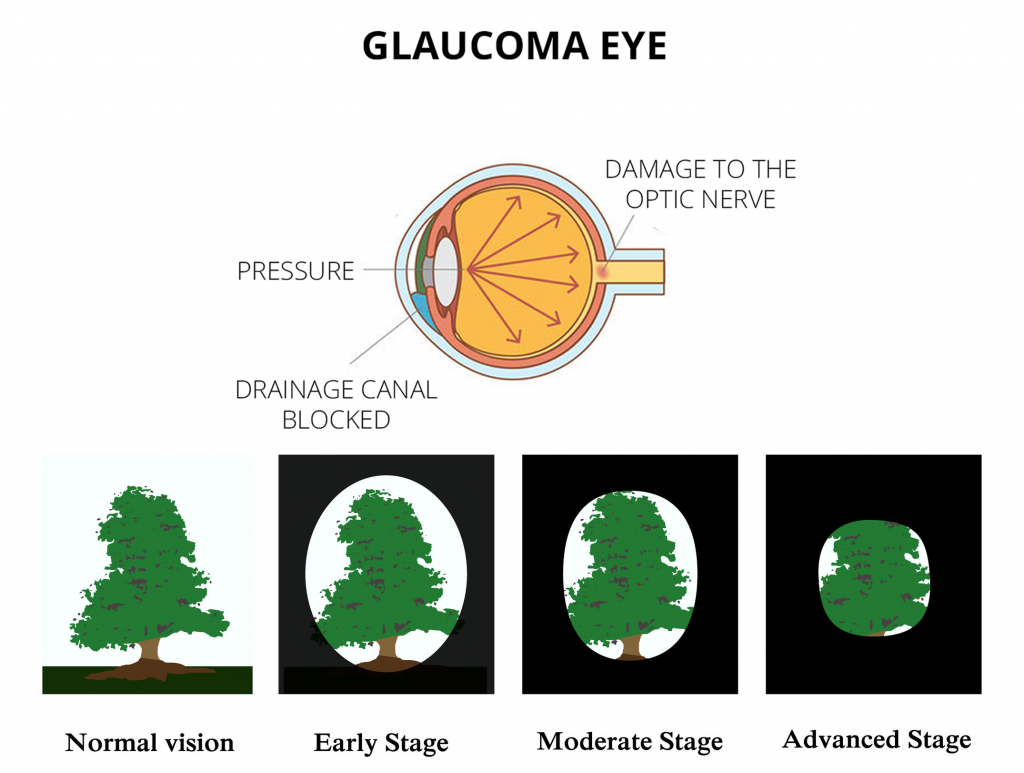
WHAT IS ACUTE GLAUCOMA?
Acute glaucoma is a condition caused by a sudden rise in the internal eyeball pressure, mainly affects the middle-aged and elderly. The patient complains of sudden onset of pain, redness and blurring of vision. The eye pain can be severe enough to cause nausea and vomiting and to be misinterpreted as a one-sided headache. Sometimes, the phenomenon of seeing coloured rings or haloes around bright lights.
Close examination of the eye will find the cornea hazy looking and without its normal transparency and luster. The pupil is dilated and fails to constrict even when a bright light is shone on it. The sudden rise in internal eyeball pressure in acute glaucoma is due to blockage of the outflow pathways of the circulating aqueous humour. The aqueous humour is the fluid which fills the front of the eye.
Sometimes the visual complaint is sudden loss of vision rather than blurred vision. The likely causes of this are acute glaucoma, retina detachment, branch retinal vein occlusion, retinal artery occlusion and diabetic eye disease.

WHAT IS CHRONIC GLAUCOMA?
Chronic glaucoma is important because it is a common cause of blindness and unlike acute glaucoma, there is usually no warning symptoms until it is too late. Chronic glaucoma can occur at any age. However, those at higher risk are adults over 45 years, patients with diabetes, patient with high myopia and those with a family history of glaucoma.
WHAT HAPPENS IN CHRONIC GLAUCOMA?
The front of our eye is filled with a clear fluid called the aqueous humour. This fluid is formed behind the iris and it flows through the pupil to drain into tiny ‘drainpipes’ located in the angle between the iris and the cornea. When these ‘drainpipes’ gets narrowed or blocked, the drainage system starts to fail and pressure will progressively damage the optic nerve.
Blurred Vision from Chronic Glaucoma
Chronic glaucoma comes on silently. There is no pain, no redness or even visual symptoms to warn of the disease until the disease reaches its advanced stages. This is because only side vision is unaffected initially and the patient is unaware of his visual loss until it is advanced. If chronic glaucoma is left undetected and untreated, more and more vision is lost until finally only a small central ‘tunnel’ of vision is left.
Therefore, it is important for those over the age of 45 years to have their eye pressure checked at least once a year, especially if they have a family members suffering from the disease or if there is a history of diabetes or high myopia.
Treatment of Chronic Glaucoma
Vision loss due to chronic glaucoma is usually permanent. Therefore, it is important to diagnose and treat the condition early. The raised eyeball pressure in chronic glaucoma can usually be controlled using pressure-lowering eye drops two to four times a day. The eye drops works either by assisting the flow of fluid out of the eye or by reducing the amount of fluid produced. Treatment for chronic glaucoma is life-long. If control of the eyeball pressure cannot be satisfactorily maintained with the eye drops, surgery or laser treatment may need to be carried out.
Glaucoma is life-long disease. Once it is diagnosed, the patient must have his eyes checked regularly by an eye doctor for life. A normal pressure after treatment means that the disease is controlled but not necessarily cured.
